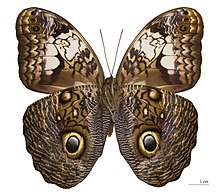Owl butterflies
| Owl butterflies | |
|---|---|
 |
|
| Caligo martia | |
| Scientific classification | |
| Kingdom: | Animalia |
| Phylum: | Arthropoda |
| Class: | Insecta |
| Order: | Lepidoptera |
| Family: | Nymphalidae |
| Subfamily: | Satyrinae |
| Tribe: | Brassolini |
| Genus: |
Caligo Hübner, [1819] |
| Type species | |
|
Caligo eurilochus Cramer, 1775 |
|
| Diversity | |
| Some 20 species | |
| Synonyms | |
|
|
The owl butterflies, the genus Caligo, are known for their huge eyespots, which resemble owls' eyes. They are found in the rainforests and secondary forests of Mexico, Central, and South America.
Owl butterflies are very large, 65–200 mm (2.6–7.9 in), and fly only a few meters at a time, so avian predators have little difficulty in following them to their settling place. However, the butterflies preferentially fly in dusk, when few avian predators are around. The Latin name may possibly refer to their active periods; means darkness.
Some owl butterflies form leks in mating behavior.
Listed alphabetically within groups:
There are some twenty species in this genus, which can be divided into six groups that might constitute subgenera. Some species are of uncertain placement with regard to these groups, however:
The underwing pattern is highly cryptic. It is conceivable that the eye pattern is a generalized form of mimicry. It is known that many small animals hesitate to go near patterns resembling eyes with a light-colored iris and a large pupil, which matches the appearance of the eyes of many predators that hunt by sight. The main predators of Caligo are apparently small lizards such as Anolis.
Caligo
According to the Batesian mimicry theory the pattern on the wings of Caligo resemble the head of a predator like a lizard or an amphibian. It should deter predators while resting, feeding, mating, or emerging from the pupa.
...
Wikipedia
